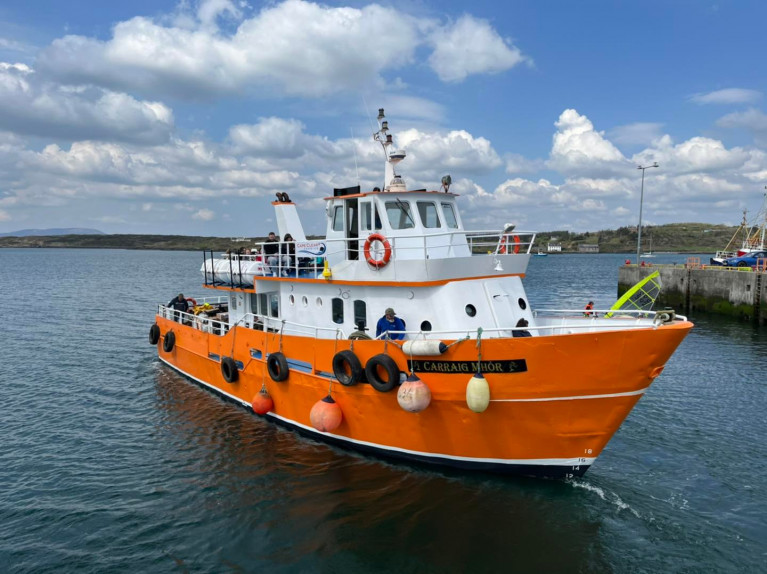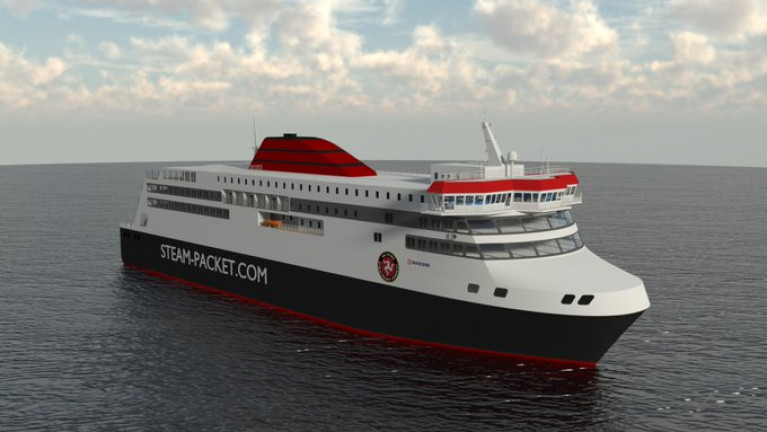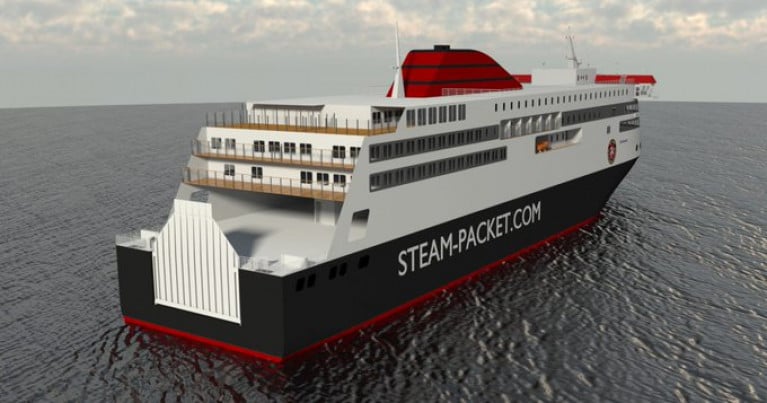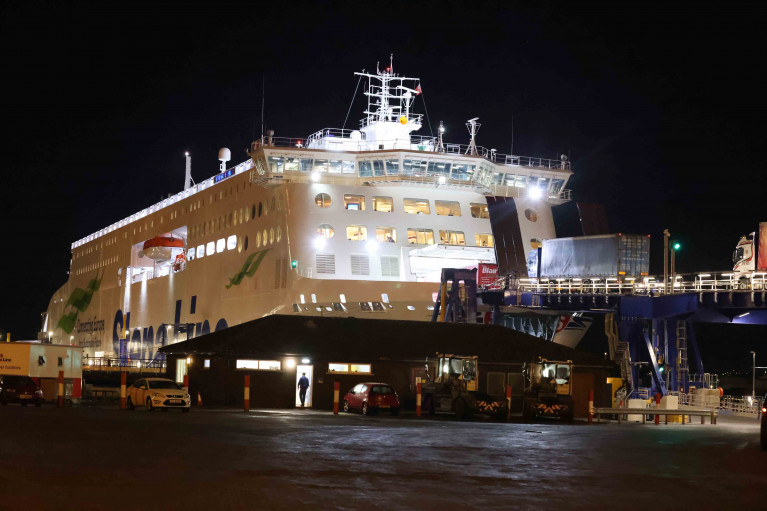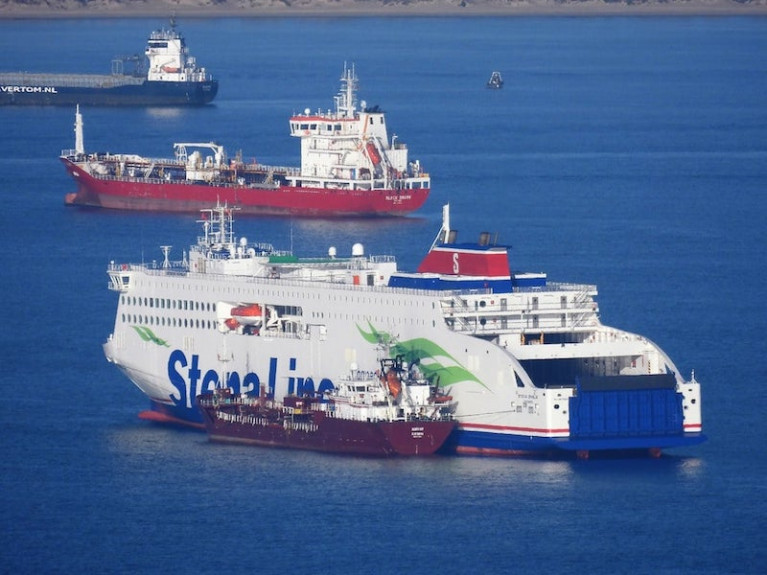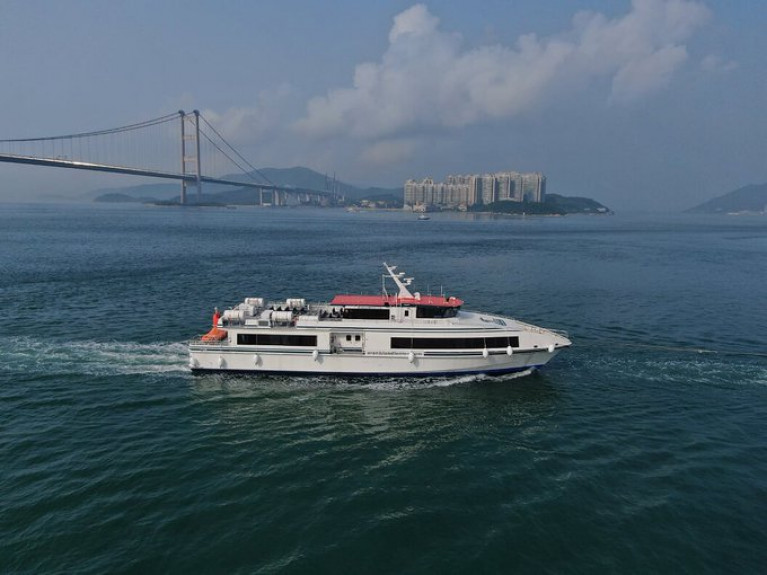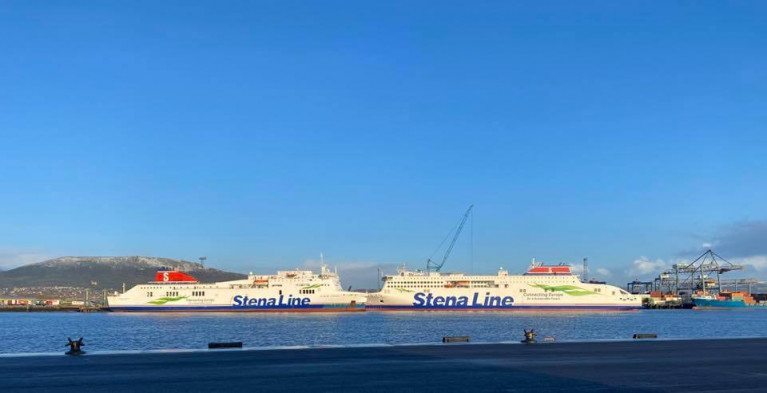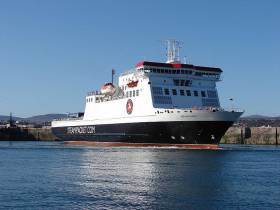Displaying items by tag: New Ferry
New Passenger Ferry and Freight Vessels for Isles of Scilly Steamship Group Is Secured following Private Funding
The Isles of Scilly, off the UK's south-west coast, is to get a new passenger ferry and freight vessels to service the life-line link between the islands and Penzance in Cornwall.
The development follows yesterday's announcement by the Isles of Scilly Steamship Group which has secured a major privately funded ship building programme to replace an existing trio of ageing vessels, among them the Scillonian III.
As Afloat previously reported, the new passenger/cargo ferry (Scillonian IV) and two new freight vessels will set sail by March 2026. The £42m project will be the single biggest investment in the 103-year history of the Company.
The deal will be financed through a £33.6m loan arranged with Lombard NatWest, one of the UK’s largest asset finance providers.
Stuart Reid, Chief Executive of the Isles of Scilly Steamship Group, said the announcement reaffirmed the Group’s long-term commitment to maintaining the lifeline service to the islands, providing certainty, reliability, and a clear timeline for replacing the current ageing fleet.
The Group launched its vessel replacement programme in 2019 to replace its veteran vessel, the Scillonian III passenger ferry, Gry Maritha freight ship and inter-islands launch Lyonesse Lady. At 46, 42 and 32 years old respectively, the existing vessels are coming to the end of their service life, suffer reliability challenges and are increasingly costly to maintain.
In 2021 the Company teamed up with partners on the islands to support a bid to the Government led by the Council of the Isles of Scilly. This saw a conditional offer of £48.5m of Levelling up Funding (LUF) in October 2021 to the Council for new vessels and infrastructure.
However, with no tangible progress made in the last 18 months following the initial offer, significant changes to the terms of the offer and growing frustration with the delay both on and off the islands, the Group has reverted to its original plan of privately financing the new vessels.
Mr Reid said:“The Group has a long and proud history of providing a lifeline route to the islands for more than a century and a dedicated team of experienced staff who understand the unique nature of the islands and the needs of its residents and businesses.”
“We are delighted to be announcing this major investment for the islands which will see vessels coming into service by March 2026. These new vessels will deliver a significant improvement in sea link services for the community and the visitor market. It provides certainty for islanders, island businesses and visitors, and the more than 200 staff that we employ on the islands and the mainland.”
The Scillonian III carries over 110,000 passengers a year and operates an essential service for both islanders and the islands’ predominantly tourist economy.
The striking new 72-metre Scillonian IV passenger ferry will carry 600 passengers (an increase of 115) over three decks with a contemporary, comfortable seating arrangement, onboard coffee shop and retail area.
It will reduce journey times, improve comfort with anti-roll fins to improve the stability of the crossing, and feature increased cargo capacity with the ability to carry higher volumes of chilled and frozen goods and improved access for passengers with reduced mobility.
Every year 15,000 tonnes of cargo are shipped to and from the Isles of Scilly. The 45-metre dedicated cargo ship to replace the Gry Maritha will have an increased cargo capacity, including more space for chilled and frozen goods and a crane which can lift eight tonnes. The new cargo vessel will have a comfortable lounge for a small number of passengers, and this will provide more travel options throughout the winter months to island residents.
The new inter-island launch will allow for faster journey times between St Mary’s and the off-islands. It will have a 50% increase in cargo capacity and a significantly reduced fuel consumption. The aluminium catamaran design will also improve access into tidal restricted off-island quays.
All three vessels will have fuel-efficient engines which will reduce emissions while providing an enhanced service and improved resilience for the Islands. The vessels will be designed and built so that they can be retrofitted with improvements in green propulsion technology when mature and proven.
Ian Howard, Chairman of Isles of Steamship Group said:“When the current Board took over in 2019, its first priority was to restore profitability and put the Company in a position where it did not have to be reliant on hand outs. We have done that. The next step is to bring in new ships which will enhance the service to the islands for passengers and for islanders’ freight needs. This is a special moment for the Company and the islands.”
Nathan Sikorski, Director, Lombard, NatWest Group said:“The Lombard team of Chris James and I are delighted to have been given the opportunity by the Isles of Scilly Steamship Group to become a key partner in delivering on this exciting new-build project, which will see the sustainability of this critical lifeline service continue for generations to come.
“Lombard’s support for the Isles of Scilly Steamship Group dates back many years having facilitated the acquisition of the original Gry Maritha. This exciting major investment will transform its fleet of vessels and secure the long-term future of the vital services it provides.”
The Steamship Group is in discussions with several shipyards and next steps will be to finalise procurement and build programmes.
New Wild Atlantic Way Ferry Sets Sail for Cape Clear Island
A ferry acquired by Cape Clear Ferries set off on its maiden crossing to the West Cork island yesterday and under the new name of Carraig Mhór, writes Jehan Ashmore.
The Baltimore based operator's latest addition saw Carraig Mhór which has lounges and outdoor viewing decks, enter service on the 2pm sailing from the harbour pier.
In addition to the Baltimore-Cape Clear Island route, the operator also serves the island from Schull, further to the west on the Mizen Peninsula.
The 96 passenger ferry previously named the Happy Hooker, had served a long career serving the Aran Islands for Doolin2Aran Ferries, having been built in 1989.
Afloat researched that the Happy Hooker had departed Rossaveel, Connemara in January and this led to a delivery voyage along the western seaboard to the ferry's new Cork coast homeport.
In order to prepare the 19.8m ferry for Cape Clear Ferries, this involved months of work carried out by their crew and by Oldcourt Boats Ltd located on the nearby River Ilen. Gone has the blue hull colour of the Doolin-based operator, as the distinctive twin funnelled Carraig Mhór emerged also with a stricking orange hull and white superstructure reflecting the ferry's new owner.
The same livery scheme is sported by Cailín Óir, a 100 passenger excursion vessel that had also been a Cape Clear ferry is run by the company's Cork Harbour Cruises which launched in 2021. Such cruises resumed this season having started during the busy Easter Bank Holiday weekend.
Returning to Carraig Mhór, which has joined another company fleetmate, the 94 passenger ferry Dún an Óir II that serves the island which is three and a half miles long by one and a half miles wide. The ferries offer the opportunity to do whale and dolphins spotting off the island's rugged coastline.
Afloat tracked the ferry's route passage which offers the added bonus of passing Sherkin Island to reach the Cape Clear where the island is rich in archaeology history with ancient standing stones, Bronze Age monuments and traditional stone walls.
Cape Clear (Oileán Chléire) has a permanent Irish speaking population of 130. During the summer this number increases significantly, noting there is an Irish Language Summer School.
Also the summer brings a lively social and traditional music scene with local joined by visitors.
Facilities on the West Cork island include restaurants and pubs, a range of accommodation including a youth hostel, yurt village, campsite, various guesthouses and a choice of holiday homes.
A Baltimore-Cape Clear Cruise is also available plus further offshore, is an excursion cruise around the Fastnet Rock Lighthouse (“Teardrop of Ireland”) which is also available from Schull.
These tours are based as the following: Fastnet Day Tour, Sunset/Twilight Tours and Direct Fastnet tours and subject to weather conditions.
Asides tourism, the company is a vital lifeline for islanders bringing cargoes but only operates out of Baltimore.
New Isle of Man Vessel Will 'Usher in New Standard' for Ferry Travel
The Isle of Man Steam Packet's managing director claims a new flagship vessel will usher in a new standard of ferry travel.
Construction is underway on the Manxman, (see: Shipyards steel-cutting ceremony) and which is expected to start operating in 2023.
The newbuild ro-pax will replace the Ben-my-Chree and with the project costing around £78m.
Brian Thomson says the new ferry will be an exciting upgrade.
ManxRadio also has a podcast on what the MD has to say.
Plans for Isle of Man Newbuild 'Manxman' Design Progressing Well Says Steam-Packet
As Afloat previously reported plans for a newbuild ferry to be named Manxman and due for delivery in 2023 replacing Ben-my-Chree, are progressing well according to the Isle of Man Steam Packet.
The detailed design of both the external and internal features of Manxman are currently being undertaken by a team of experts. This vital phase is the longest and where some of the most important decisions are made.
A range of work will take place over a period of around 12 months, including the development of a 3D detailed design drawing of the vessel, as well as construction drawings to allow the vessel to be built. In addition, interior design and internal layouts will be finalised and vessel equipment and machinery agreed.
Despite the ongoing impact of the pandemic, significant progress has been made over the last 12 months. In July, it was announced that the vessel will be built at Hyundai Mipo Dockyard (HMD) in South Korea, one of the world’s major shipbuilders and a leading blue chip name in the industry.
In December, after much deliberation and taking the views of the public into consideration, it was revealed that the new vessel will be named Manxman. More than 7,500 people submitted their favourite from the shortlist of names, the results of which played a key part in the selection process.
Isle of Man Steam Packet Company Chief Executive Mark Woodward said: ‘We are pleased with how plans are progressing and that, despite the pandemic, we have largely been able to stay on schedule and continue to make significant progress. It is a large-scale project which naturally takes time and many hours of meticulous planning, however we are excited to move forward with the detailed design of Manxman.’
There are many stages involved in the process which the Steam Packet Company covers in detail in its two-part blog series, Designing & Constructing a Vessel.
Part one looks at what is involved in the planning, design and construction of a bespoke ferry and the different steps involved in the process.
As for Part two, this provides a unique insight into how long the whole process usually takes, the types of specialist organisations it will be working with and the challenges the ferry company faces over the next few years.
Ferry Operator's New Stena Embla Makes Maiden Sailing on Belfast-Birkenhead (Liverpool) Route
The newest Stena Line ferry on the Irish Sea made its inaugural crossing on the Belfast-Birkenhead (Liverpool) service last night and as Afloat adds this follows a debut albeit temporarily on the Rosslare-Cherbourg route to enable extra capacity.
Stena Embla joined another E-Flexer ro-pax class Stena Edda on the popular Belfast – Liverpool route with the capacity to carry 1,000 passengers, 120 cars and with 3,100 freight lane meters.
The Chinese built newbuild will increase the Belfast – Liverpool service freight capacity by 20% and raise passenger capacity by 33%.
Paul Grant, Stena Line’s Irish Sea Trade Director said: “Stena Embla will make one daily return trip between Belfast and Liverpool. We have now invested over £400m in our ferries and port facilities on the Irish Sea in recent years. The Belfast-Liverpool route is one of the most popular Irish Sea crossings for both freight and leisure traffic so having a second vessel of the calibre of Stena Embla, with a host of high-quality passenger facilities, will further increase its appeal and expand our capacity. In March 2020 we launched our new build Stena Edda onto the Belfast-Liverpool service and the feedback from our freight and leisure customers was extremely positive.
He added "Now we will have two ships offering identical services and facilities which will help take our service levels on the route to new heights. We have real confidence in the future of our Belfast services and our Irish Sea routes in general, which is why this region has attracted three brand new ships in the last 12 months alone.”
New Stena 'E-Flexer' Ropax Makes Delivery Voyage Completing Trio for Irish Sea Service
Stena Embla the latest Chinese newbuild 'E-Flexer' class ropax completed a month-long delivery voyage to Europe where the ferry is to join sisters on the Irish Sea, writes Jehan Ashmore.
The 40,050 gross tonnage newbuild built in Weihai, was tracked by Afloat.ie on the evening of New Year's Day in the Celtic Sea heading into the Irish Sea bound for Holyhead, Wales to where a brief call was made in the early hours of the next day before proceeding to Belfast Harbour. The new ferry berthed at the port's VT2 terminal.
The last port of call during Stena Embla's long delivery voyage was the southern Spanish port of Algerciras, opposite of Gibraltar, having called previously via Singapore, Sri Lanka and then a transit of the Suez Canal.
The Spanish call was to enable 'bunkers' transferred from a small tanker. On a related note, at the same time Stena Embla was tracked in the Celtic Sea, another tanker, Lizrix from Falmouth, was anchored off Rosslare Europort prior to entering the Wexford port to refuel Stena Horizon serving on the Cherbourg route.
The French service was recently boosted in freight capacity as the ro-ro Stena Foreteller took up service before Christmas which was earlier than planned to tomorrow's original start-up date. This was due to a major surge in demand from hauliers to arrive in mainland Europe and avoid customs checks of a post-Brexit UK.
While there is much attention to yesterday's newest 'Brexit-buster' route to Dunkirk operated by DFDS, Stena will introduce Stena Embla as the second E-Flexer on the Irish Sea between Belfast and Birkenhead (Liverpool). The new ferry has a capacity for 1,000 passengers, 120 cars and 3,100 lane metres of freight.
The other E-Flexer is Stena Edda along with Stena Mersey currently operates the 8 hour route. Each of the E-Flexers, have 40% more deck capacity, 40% more cabins and 30% more fuel-efficient than the Stena Mersey which will be replaced by the newbuild.
Stena Mersey along with former fleetmate and sister Stena Lagan (lenghtened last year to increase freight capacity), was in March replaced by the the E-Flexer, Stena Edda. Both of the 'river' theme named ropax vessels will be reunited when work also to enlarge Stena Mersey is due for completion next summer. At that stage, both the pair will have been renamed to reflect a deployment to a Baltic Sea route for the same operator.
As for the third E-Flexer on the Irish Sea, this is the leadship of the class Stena Estrid which entered service almost a year ago on the Dublin-Holyhead route. This winter the ferry was on relief duty between Belfast-Birkenhead but is back operating routine duties on the premier Irish Sea route.
In total Stena Ro Ro has ordered 9 of the Stena E-Flexer class and all built in China, though last year there was a change of ownership at the shipyard in Weihai.
Three of the newbuilds have been chartered to Brittany Ferries, firstly the Galicia which made a debut in December on UK-Spain service whereas DFDS will receive their E-flexer on the short-sea Dover-Calais service this year.
Aran Islands Ferry to Become Ireland's Largest Domestic Passenger Ferry to Enter Service 2021
A new ferry will be Ireland's largest domestic passenger ferry when the 40-metre 'Saoirse na Farraige' arrives in Galway Bay this October.
As Independent.ie writes the ferry constructed in Hong Kong with a capacity of 400, is expected to enter service next April with Aran Island Ferries.
It will operate from Rossaveel, Co Galway to all three Aran Islands, taking 45-minutes to reach Inis Mór, 50 minutes to Inis Meáin and 55 minutes to Inis Oírr, the company says.
'Saoirse na Farraige' is the sixth ship for a company owned by the O'Brien family of Connemara, who first began carrying passengers to the Aran Islands on a Galway Hooker, under sail, decades ago.
"We know it’s an extremely difficult time for businesses in many sectors (ours included), but we hope this will brighten up Galwegians’ spirits and that when we travel again, the ferry will have a positive impact on tourism in the west of Ireland," said Sales and Marketing Manager, Áine McLoughlin.
For furthermore on this newbuild ferry click here.
The newest Stena Line roll-on/roll-off passenger ferry which arrived in Belfast Harbour from China (as Afloat reported) ahead of being put into service on the Irish Sea next month, has undergone rigorous checks for coronavirus.
The Stena Edda, which has been six years in planning and construction, will operate on the Belfast to (Birkenhead) Liverpool route, replacing the Stena Lagan.
It was built at the AVIC Weihai Shipyard in north-eastern China, which is 1,000 miles from the Wuhan province, where the coronavirus outbreak has its origins.
The Irish News reports that it emerged since the vessel left Weihai four weeks ago, it has undergone a series of checks along the route to ensure it is carrying no traces of the potentially deadly virus.
To read more including a response from the ferry operator click here.
Brand New Stena E-Flexer Completes Maiden Delivery Voyage to Belfast Harbour
The brand new 'next generation' ropax ferry Stena Edda for the first time arrived into Belfast Harbour this morning following a 10,500 mile delivery voyage from China, writes Jehan Ashmore.
Afloat also tracked the Chinese built Stena Line E-Flexer ropax class yesterday at anchor in Belfast Lough having sailed up the Irish Sea. Following an overnight anchorage the 40,000 gross tonnage ferry made a maiden arrival in Belfast Port this morning having docked at the VT2 terminal for berthing trials.
Stena Edda is understood to enter the Belfast-Birkenhead (Liverpool) route next month and will become amongst the most environmentally sustainable vessels in the Irish Sea. At 215 metres in length, Stena Estrid is larger than today’s standard ropax vessels, with space to carry 120 cars and 1,000 passengers, and a freight capacity of 3,100 lane meters. This will be a boost to the route as there is a 50 per cent increase in freight tonnage.
Introduction of Stena Edda will also result in the direct replacement of Stena Lagan. In addition another new sister, Stena Embla is also to debut on the Irish Sea route ultimately leading in the withdrawal of the route's second ship sister, Stena Mersey.
In order to accommodate the E-Flexers, a new double tier berth linkspan has been installed in Belfast Harbour. While in Birkenhead, further adaptive works as Afloat previously reported began at the Twelve Quays River Terminal on Merseyside. The route is the longest on the Irish involving a 8-hour passage time.
Already in service on the Irish Sea is the leadship of the E-Flexer class, Stena Estrid which entered on the Dublin-Holyhead route last month.
Isle of Man Steam Packet: What Do You Think About A New Ferry?
The Isle of Man Steam Packet Company wants public opinion on a new ship.
The ferry operator reports Manx Radio, wants to know your thoughts, as it prepares for 'major investment in its fleet'.
The company has plans to replace the Ben-my-Chree with a purpose-built ship, designed and constructed over the next three years.
Passengers past, present and future are invited to submit their views, specifically relating to on-board facility preferences, through a survey (click here) which is being hosted by Island Global Research.
For more click here.



























